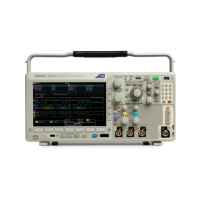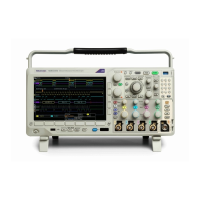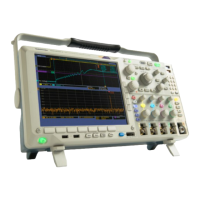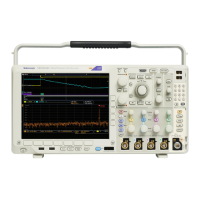Command Groups
Search Comman
dGroup
The search commands let you analyze your source waveform record for conditions
specified by a search’s criteria. Once these criteria are matched, the oscilloscope
places a sear
ch mark at that location in the waveform record. You can then
navigate or save the marks. (See page 2-30, Mark Command Group.)
When perfor
ming an edge, pulse width, runt, transition (rise/fall time), time-out,
or bus search, you can use only one waveform at a time.
When perfo
rming a logic or a setup/hold search, you can use any or all of the
displayed waveforms at the same time. For example, with a logic search, you can
search for instances when CH1 is high and CH2 is low. Likewise, with a setup
and hold search, you can search for instances when the clock source is CH1 and
the data sources are CH2 and CH3.
With pulse width searching, the oscilloscope can search for pulses with widths
less than, greater than, equal to, or not equal to a specified time. Additionally, it
can search for pulses with widths within, or outside of a range of two different
specifi
ed times. Searching can take place on either positive or negative pulses.
Searches on RF waveforms can only use time domain traces (RF Amplitude vs.
Time,
RF Frequency vs. Time and RF Phase vs. Time). (MDO4000/B/C only.)
A series of example command sequences showing different searches and triggers
is in
cluded as an appendix. (See page F-1, Search and Tr igger Command
Sequence Examples.)
Searching using
Thr
esholds
All search types except bus searches use thresholds, which are vertical values that
th
e source waveform must cross in order for a mark to be placed. For example, if
you set the search type to EDGE, and the search source to CH1, the search’s slope
to RISE, and the search’s threshold value to 1.5V, then that search will find all
places where CH1 transitions from below 1.5 volts to above 1.5 volts.
Each individual search source waveform has two threshold values: a low threshold
and a high threshold. Note that if you change the search source waveform, you
must explicitly set the thresholds. For example, if you set the search’s CH1lower
threshold to 1.5 volts, and then decide to change the search’s source waveform to
CH2, you must then explicitly set CH2’s lower threshold value to the value you
would like (it will not automatically be 1.5 volts). If you have an edge search set
up on CH1 with the threshold you’d like, then decide to change to a logic search
and change the threshold on CH1 to fit your logic search, and then change back to
an edge search, your initial threshold setting on the edge search will be lost.
MDO4000/B/C, MSO/DPO4000B and MDO3000 Series Oscilloscopes Programmer Manual 2-61

